
|
Now it is 7.0 mag (Sept. 14, Marco Goiato). It keeps so bright as 6-8 mag for a long time from 2011 to 2012, and will be observable in good condition in the Northern Hemisphere. In the Southern Hemisphere, it keeps observable in good condition until October when it brightens up to 6.5 mag.
Date(TT) R.A. (2000) Decl. Delta r Elong. m1 Best Time(A, h)
Sept.17 18 40.31 19 53.6 1.540 2.033 104 6.8 19:16 (174, 35)
Sept.24 18 22.93 19 40.5 1.616 1.976 95 6.8 19:21 (160, 33)
|
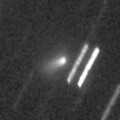
|
It passed very near by the earth, within 0.1 A.U., and brightened up to 8.0 mag in the southern sky (Aug. 14, Willian Souza). It appeared in the morning sky in the Northern Hemisphere. Now it is very bright as 7.5 mag (Sept. 15, Todd Augustyniak). It keeps observable while fading gradually after this. In the Southern Hemisphere, it is not observable until winter when it becomes fainter than 16 mag.
Date(TT) R.A. (2000) Decl. Delta r Elong. m1 Best Time(A, h)
Sept.17 9 50.95 8 15.8 0.527 0.586 26 7.5 4:33 (260, 0)
Sept.24 10 6.46 8 51.4 0.673 0.539 30 7.2 4:23 (259, 0)
|
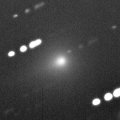
|
It has brightened faster than expected, and reached up to 8.1 mag in mid August (Aug. 19, Michael Mattiazzo). However, it turned to be fading and got diffuse rapidly after that. It has been already became fainter than 10.5 mag and unable to be detected (Sept. 14, Michael Mattiazzo). Altnough it was expected to be a naked eye comet, the nucleus is disintegrating and the comet will disappear soon. However, it is still detected by STEREO spacecraft images at 12-13 mag (Sept. 11, Alan Watson). It is not observable now. After appearing in the morning sky in October, it becomes observable in the excellent condition at midnight. However, the comet can be already too faint to see.
Date(TT) R.A. (2000) Decl. Delta r Elong. m1 Best Time(A, h)
Sept.17 12 47.04 -4 46.0 0.564 0.507 19 10.3 19:16 ( 84, 0)
Sept.24 12 28.01 -1 34.2 0.428 0.581 6 10.4 19:21 ( 79,-13)
|

|
Now it is 10.0 mag (Sept. 7, Juan Jose Gonzalez). It will brighten up to 10-11 mag in autumn. In the Northern Hemisphere, it keeps observable for a long time until 2012 spring. In the Southern Hemisphere, it is not observable until November.
Date(TT) R.A. (2000) Decl. Delta r Elong. m1 Best Time(A, h)
Sept.17 7 53.19 53 0.2 2.132 1.989 68 10.6 4:33 (210,-10)
Sept.24 7 47.50 52 0.9 2.022 1.998 74 10.6 4:23 (208, -7)
|

|
New comet discovered in the spacecraft images. Now it is so bright as 10.5 mag (Sept. 15, Chris Wyatt). In the Southern Hemisphere, it must have located high and been observable in excellent condition from spring to summer. It locates high still now. But it will be getting lower in the evening sky after this, and it will be unobservable in late September. In the Northern Hemisphere, it locates extremely low and hard to observe. It will appear in the morning sky at 15 mag in late November, then it will be observable while fading gradually.
Date(TT) R.A. (2000) Decl. Delta r Elong. m1 Best Time(A, h)
Sept.17 14 15.60 -14 44.4 1.613 1.114 42 11.0 19:16 ( 88, 24)
Sept.24 14 17.03 -11 49.7 1.764 1.113 35 11.2 19:21 ( 87, 16)
|
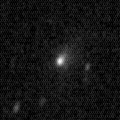
|
It brightened up to 15.0 mag on July 10 (Ken-ichi Kadota). The condition of this apparition is bad. In the Northern Hemisphere, it is only observable from December to February in the evening very low sky after the perihelion passage. In the Southern Hemisphere, it keeps observable for a long time, although it keeps locating extremely low. The component B was not detected, fainter than 20 mag, on May 14 (Hidetaka Sato).
Date(TT) R.A. (2000) Decl. Delta r Elong. m1 Best Time(A, h)
Sept.17 13 25.50 -6 32.4 1.802 1.038 28 12.6 19:16 ( 88, 10)
Sept.24 13 50.61 -9 57.1 1.755 1.001 28 12.4 19:21 ( 84, 10)
|
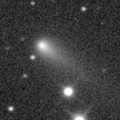
|
Already bright and visible visually at 12.2 mag (Sept. 15, Chris Wyatt). It will be observable in good condition at 12 mag in autumn and winter.
Date(TT) R.A. (2000) Decl. Delta r Elong. m1 Best Time(A, h)
Sept.17 23 52.42 5 57.7 1.226 2.224 170 12.7 0:12 (180, 49)
Sept.24 23 48.39 5 8.9 1.201 2.201 174 12.5 23:36 (180, 50)
|
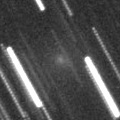
|
Extremely diffuse. It is faint as 15.0 mag by CCD observations (Aug. 20, Michael Jager). The central part is extremely faint as 18 mag. However, it was reported so bright as 9.2 mag visually (Sept. 7, Juan Jose Gonzalez). In the Northern Hemisphere, it keeps observable until winter, although it becomes very low from mid August to late September. In the Southern Hemisphere, it is not observable until November. It will keep the current brightness until autumn in calculation. However, it may be disintegrated in the near future.
Date(TT) R.A. (2000) Decl. Delta r Elong. m1 Best Time(A, h)
Sept.17 11 1.42 29 35.6 1.662 0.912 28 12.7 4:33 (250,-25)
Sept.24 11 9.93 23 47.9 1.719 0.944 27 12.9 4:23 (255,-21)
|

|
First return of a new periodic comet which brightened up to 13 mag in a major outburst in 2005. Now it is bright as 11.2 mag (Sept. 7, Juan Jose Gonzalez). It will be observable in an excellent condition from summer to winter. The fragment B is also observed at 19-20 mag. Another fragments C and D at 22 and 21 mag were observed on Sept. 7 at Ishigakijima Observatory.
Date(TT) R.A. (2000) Decl. Delta r Elong. m1 Best Time(A, h)
Sept.17 22 49.56 4 31.9 1.236 2.225 166 13.4 23:05 (180, 50)
Sept.24 22 44.84 4 26.4 1.270 2.240 160 13.5 22:32 (180, 51)
|

|
Now it is so bright as 13.0 mag (Sept. 1, Hidetaka Sato). It keeps bright as 13-14 mag for a long time after this until 2013. It is not observable in the Northern Hemisphere, but it is observable in good condition in the Southern Hemisphere.
Date(TT) R.A. (2000) Decl. Delta r Elong. m1 Best Time(A, h)
Sept.17 11 39.35 -75 24.1 5.632 5.510 77 13.5 19:16 ( 16, 29)
Sept.24 11 47.48 -75 56.4 5.663 5.503 75 13.5 4:23 (345, 30)
|
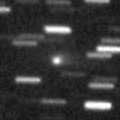
|
It brightened rapidly and reached up to 13.5 mag (Sept. 14, Artyom Novichonok and Vladimir Gerke). It will be obserbale at 13-14 mag in good condition in autumn. It locates somewhat low in the Southern Hemisphere.
Date(TT) R.A. (2000) Decl. Delta r Elong. m1 Best Time(A, h)
Sept.17 7 17.29 8 39.5 1.582 1.468 64 14.3 4:33 (234, 29)
Sept.24 7 39.70 8 36.5 1.537 1.451 65 14.0 4:23 (235, 28)
|

|
Now it is 13.5 mag, much brighter than originally expected (Aug. 20, Michael Jager). It keeps 14 mag from 2011 summer to 2012 summer. But it is not observable around the perihelion. It is observable in good condition in the Northern Hemisphere in 2011, and in the Southern Hemisphere in 2012. It was reported that it is very bright as 10.3 mag with a large coma of 6 arcmin visually (Aug. 26, Juan Jose Gonzalez). However, it looks very small by CCD images.
Date(TT) R.A. (2000) Decl. Delta r Elong. m1 Best Time(A, h)
Sept.17 14 45.98 4 54.8 3.123 2.551 47 14.1 19:16 (110, 19)
Sept.24 14 57.82 3 16.0 3.142 2.521 44 14.0 19:21 (105, 16)
|

|
Now it is 13.7 mag and visible visually (Sept. 2, Jakub Cerny). It will be observable at 13-14 mag for a long time from 2011 to 2012.
Date(TT) R.A. (2000) Decl. Delta r Elong. m1 Best Time(A, h)
Sept.17 18 5.23 -10 17.1 5.153 5.378 97 14.0 19:16 (150, 62)
Sept.24 18 1.71 -10 42.2 5.268 5.362 89 14.1 19:21 (134, 58)
|

|
Now it is bright as 13.7 mag (Sept. 14, Hidetaka Sato). It is observable in good condition in the Southern Hemisphere. But it will be getting lower, and will be unobservable in early November. It will brighten up to 11-12 mag in winter, however, it is not observable around the perihelion passage. In the Northern Hemisphere, it is not observable until 2012 summer, when it will be fainter than 15 mag.
Date(TT) R.A. (2000) Decl. Delta r Elong. m1 Best Time(A, h)
Sept.17 14 31.98 -36 13.5 2.604 2.211 56 14.2 19:16 ( 68, 37)
Sept.24 14 47.82 -35 39.7 2.598 2.140 52 14.1 19:21 ( 67, 33)
|

|
Big asteroid discovered in 1906. It suddenly showed the cometary activity on Dec. 11, probably due to an impact of a small object. It was very bright as 11.5 mag visually (Dec. 17, Juan Jose Gonzalez). It had a dust coma still on Jan. 9 (Joseph Brimacombe). Then it turned to be stellar at 13.8 mag (Apr. 5, Juan Jose Gonzalez). Now it is not observable.
Date(TT) R.A. (2000) Decl. Delta r Elong. m1 Best Time(A, h)
Sept.17 12 16.89 8 59.4 3.633 2.658 11 14.2 19:16 ( 91,-14)
Sept.24 12 28.08 7 37.0 3.629 2.647 10 14.2 19:21 ( 87,-17)
|

|
Now it is not observable. It will appear in the morning sky in early November.
Date(TT) R.A. (2000) Decl. Delta r Elong. m1 Best Time(A, h)
Sept.17 11 40.87 -4 13.3 7.258 6.261 6 14.3 19:16 ( 75,-13)
Sept.24 11 45.64 -4 47.1 7.258 6.261 6 14.3 4:23 (285,-12)
|
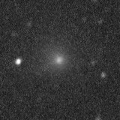
|
It has returned after 27-year blank since 1984. It brightened very rapidly, and became very bright as 9.1 mag (July 10, Tsutomu Seki). However, it is not observable now. It will never be observable again in this apparition. It is visible in SWAN images still on Sept. 13 (Hirohisa Sato).
Date(TT) R.A. (2000) Decl. Delta r Elong. m1 Best Time(A, h)
Sept.17 10 41.71 -8 48.8 2.013 1.100 17 14.3 4:33 (281, 0)
Sept.24 11 4.89 -11 56.3 2.098 1.188 18 15.1 4:23 (284, 0)
|
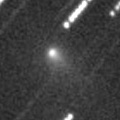
|
It was very bright and visible visually as 12.4 mag in July and early August (Aug. 2, Jakub Koukal). Now it is fading, but still bright as 13.7 mag (Sept. 3, Jakub Cerny). In the Northern Hemisphere, it keeps observable at 14-15 mag in good condition until autumn. It locates low in the Southern Hemisphere.
Date(TT) R.A. (2000) Decl. Delta r Elong. m1 Best Time(A, h)
Sept.17 17 41.49 34 12.5 1.712 1.979 89 14.6 19:16 (163, 18)
Sept.24 17 35.61 34 11.8 1.826 2.001 84 14.8 19:21 (155, 16)
|

|
It brightened up to 17.1 mag in late June (June 24, J. F. Hernandez). It will brighten up to 13 mag in winter. But the condition of this apparition is bad, and it will not be observable around the perihelion passage. It is already too low to observe in the Northern Hemisphere. It will be unobservable soon also in the Southern Hemisphere.
Date(TT) R.A. (2000) Decl. Delta r Elong. m1 Best Time(A, h)
Sept.17 13 26.37 -6 28.8 2.597 1.784 28 15.0 19:16 ( 88, 9)
Sept.24 13 42.30 -8 26.9 2.596 1.754 26 14.8 19:21 ( 84, 7)
|

|
It is not observable at all due to the bad condition in this apparition.
Date(TT) R.A. (2000) Decl. Delta r Elong. m1 Best Time(A, h)
Sept.17 11 47.15 7 54.5 2.628 1.632 5 15.0 19:16 ( 86,-19)
Sept.24 12 5.52 6 1.1 2.666 1.672 6 15.3 19:21 ( 82,-21)
|

|
Brightening rapidly. Now it is visible visually at 13.6 mag (Sept. 3, Jakub Cerny). It is expected to be 13 mag and will be observable in good condition in 2013. In the Northern Hemisphere, it keeps observable for a long time after this. It is not observable in the Southern Hemisphere.
Date(TT) R.A. (2000) Decl. Delta r Elong. m1 Best Time(A, h)
Sept.17 1 0.06 65 58.5 6.866 7.269 109 15.1 1:20 (180,-11)
Sept.24 0 46.70 66 1.9 6.781 7.242 113 15.1 0:39 (180,-11)
|
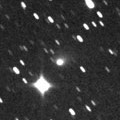
|
It brightened rapidly. Now it is bright and visible visually at 14.2 mag (Aug. 7, Alan Hale). It will be observable at 15 mag in good condition from July to October. It locates somewhat low in the Northern Hemisphere.
Date(TT) R.A. (2000) Decl. Delta r Elong. m1 Best Time(A, h)
Sept.17 20 15.79 -28 4.8 1.565 2.303 125 15.1 20:32 (180, 83)
Sept.24 20 19.20 -28 16.7 1.633 2.301 119 15.2 20:08 (180, 83)
|
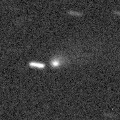
|
Appearing in the morning sky, it was revealed to be a comet. Now it is very bright as 14.7 mag (Aug. 1, G. V. Borisov, V. Rumyantsev). It has already passed the perihelion in April, and it will be fading after this. But it is still bright as 13.8 mag (Sept. 4, Sandor Szabo). In the Northern Hemisphere, it keeps observable in excellent condition for a long time until 2012 summer. It is not observable at all in the Southern Hemisphere. If the current brightness is temporal, it may fade out rapidly.
Date(TT) R.A. (2000) Decl. Delta r Elong. m1 Best Time(A, h)
Sept.17 9 18.03 48 15.9 2.829 2.390 54 15.2 4:33 (222,-17)
Sept.24 9 36.94 48 8.7 2.824 2.437 57 15.3 4:23 (223,-17)
|

|
It was expected to keep 14-15 mag for a long time from 2011 summer to 2012 summer. However, it is lost. It was observed only during two days in 2010 June. So the orbital elements are extremely uncertain. The condition is good in the Southern Hemisphere. But in the Northern Hemisphere, it is not observable until 2012 August.
Date(TT) R.A. (2000) Decl. Delta r Elong. m1 Best Time(A, h)
Sept.17 15 38.30 -53 43.2 2.885 2.802 75 15.3 19:16 ( 46, 51)
Sept.24 15 41.08 -54 24.9 2.931 2.759 70 15.2 19:21 ( 45, 46)
|

|
It will brighten up to 11 mag in autumn. However, it is not observable at all due to the bad condition in this apparition.
Date(TT) R.A. (2000) Decl. Delta r Elong. m1 Best Time(A, h)
Sept.17 10 38.84 9 0.8 2.225 1.286 15 16.3 4:33 (266,-10)
Sept.24 11 3.70 7 2.4 2.169 1.237 16 15.3 4:23 (269,-10)
|
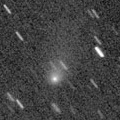
|
Now it is bright at 13.8 mag and visible visually (Sept. 2, Jakub Cerny). It will be fading slowly after this, and it will be fainter than 18 mag in December.
Date(TT) R.A. (2000) Decl. Delta r Elong. m1 Best Time(A, h)
Sept.17 22 31.68 -24 54.4 2.567 3.490 152 15.5 22:46 (180, 80)
Sept.24 22 22.57 -27 0.9 2.679 3.539 143 15.7 22:10 (180, 82)
|
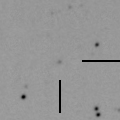
|
Now it is 17.5 mag (Aug. 17, K. Hills). It is already unobservable in the Northern Hemisphere. It is getting lower in the evening sky, and will be too low to observe in late October also in the Southern Hemisphere.
Date(TT) R.A. (2000) Decl. Delta r Elong. m1 Best Time(A, h)
Sept.17 13 59.36 -19 5.2 2.413 1.785 41 15.9 19:16 ( 82, 23)
Sept.24 14 16.87 -20 20.5 2.421 1.755 38 15.8 19:21 ( 79, 21)
|

|
Now it is bright and visible visually at 14.5 mag (Aug. 29, Jakub Cerny). Brighter than originally predicted. It will be observable at 14-15 mag in good condition from summer to autumn.
Date(TT) R.A. (2000) Decl. Delta r Elong. m1 Best Time(A, h)
Sept.17 23 1.55 -20 9.0 1.218 2.191 160 15.9 23:17 (180, 75)
Sept.24 22 58.00 -20 16.6 1.259 2.207 154 16.0 22:46 (180, 75)
|

|
It became bright as 12 mag in 2010. Now it is fading. It has already faded down to 16.3 mag (Sept. 11, Artyom Novichonok and Vladimir Gerke).
Date(TT) R.A. (2000) Decl. Delta r Elong. m1 Best Time(A, h)
Sept.17 2 16.10 3 36.3 2.961 3.784 139 16.1 2:35 (180, 51)
Sept.24 2 12.78 3 16.3 2.921 3.803 147 16.1 2:04 (180, 52)
|

|
Now it is 15.8 mag (Aug. 16, Artyom Novichonok). It will be fading very slowly after this. In the Northern Hemisphere, it keeps observable for a long time until 2012 spring when it fades down to 17-18 mag. It will not be observable in the Southern Hemisphere.
Date(TT) R.A. (2000) Decl. Delta r Elong. m1 Best Time(A, h)
Sept.17 22 33.30 50 43.8 4.677 5.318 125 16.1 22:48 (180, 4)
Sept.24 22 30.59 49 47.8 4.687 5.347 126 16.1 22:18 (180, 5)
|

|
Now it is 16.3 mag (Sept. 4, Siding Spring Survey). It is expected to be observable at 13 mag for a long time from 2012 summer to 2013 summer. It will be observable in excellent condition in the Southern Hemisphere. But it is not observable at brightest time in the Northern Hemisphere. It keeps observable for a while at 16 mag while brightening gradually.
Date(TT) R.A. (2000) Decl. Delta r Elong. m1 Best Time(A, h)
Sept.17 2 56.92 -18 22.5 4.057 4.748 128 16.3 3:16 (180, 73)
Sept.24 2 52.52 -20 10.3 3.941 4.689 133 16.2 2:44 (180, 75)
|
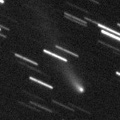
|
It reached up to 14 mag in 2010 autumn and winter. Now it is fading. It has already faded down to 16.6 mag (Sept. 14, Hidetaka Sato). In the Southern Hemisphere, it keeps observable in good condition while fading gradually. In the Northern Hemisphere, it will never be observable again.
Date(TT) R.A. (2000) Decl. Delta r Elong. m1 Best Time(A, h)
Sept.17 6 34.61 -57 4.4 3.621 3.661 84 16.2 4:33 (324, 58)
Sept.24 6 35.79 -60 12.0 3.639 3.700 85 16.3 4:23 (331, 58)
|
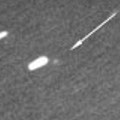
|
Now it is 17.0 mag (Aug. 27, Artyom Novichonok). It will reach up to 10 mag from January to March, but it will be too low to observe. It will be getting lower in the evening sky. In the Northern Hemisphere, it keeps observable until December when it brightens up to 12 mag. In the Southern Hemisphere, it is observable only until October when it becomes 15 mag.
Date(TT) R.A. (2000) Decl. Delta r Elong. m1 Best Time(A, h)
Sept.17 15 48.09 6 46.1 2.367 2.106 62 16.6 19:16 (123, 29)
Sept.24 15 57.45 5 43.2 2.368 2.044 59 16.3 19:21 (118, 25)
|

|
It has brightened in outburst up to 14 mag in 2006 January. Another outburst occured in late May, and brightened up to 14.3 mag (June 4, Juan Jose Gonzalez). It was bright as 14.5 mag still on June 27 (Jakub Koukal). Recent brightness has not been reported. It will be getting lower in the evening sky after this, and will be unobservable in October.
Date(TT) R.A. (2000) Decl. Delta r Elong. m1 Best Time(A, h)
Sept.17 16 8.90 -16 50.1 8.517 8.226 69 16.4 19:16 (104, 48)
Sept.24 16 11.32 -16 59.4 8.603 8.207 63 16.5 19:21 ( 99, 42)
|

|
Now it is 16.0 mag (Aug. 19, J. F. Hernandez). It is visible visually at 15.0 mag (Aug. 23, Jakub Cerny). It will brighten up to 16 mag from summer to autumn, and will be observable in good condition.
Date(TT) R.A. (2000) Decl. Delta r Elong. m1 Best Time(A, h)
Sept.17 17 15.29 -11 4.6 1.863 2.042 85 16.5 19:16 (129, 57)
Sept.24 17 27.95 -11 57.3 1.924 2.038 81 16.6 19:21 (122, 54)
|

|
Now it is 16.5 mag (Aug. 1, Hidetaka Sato). In the Southern Hemisphere, it keeps observable at 16-17 mag for a long time from 2011 to 2013. In the Northern Hemisphere, it is only observable until October.
Date(TT) R.A. (2000) Decl. Delta r Elong. m1 Best Time(A, h)
Sept.17 17 7.21 -22 46.3 4.832 4.836 84 16.8 19:16 (109, 63)
Sept.24 17 8.41 -23 35.4 4.914 4.802 77 16.8 19:21 (100, 57)
|
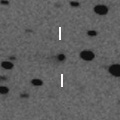
|
Now it is 16.6 mag (Aug. 29, Artyom Novichonok). It keeps observable at 17 mag for a long time from 2011 to 2012.
Date(TT) R.A. (2000) Decl. Delta r Elong. m1 Best Time(A, h)
Sept.17 0 22.98 17 48.5 7.109 8.042 156 16.8 0:42 (180, 37)
Sept.24 0 17.29 17 22.7 7.083 8.045 162 16.8 0:09 (180, 38)
|

|
Now it is 17.5 mag (Sept. 6, Leonid Elenin). It tends to be brightest after the perihelion passage. In the Northern Hemisphere, it keeps observable at 17 mag in good condition from autumn to winter. In the Southern Hemisphere, it locates low and will be hard to observe.
Date(TT) R.A. (2000) Decl. Delta r Elong. m1 Best Time(A, h)
Sept.17 8 49.48 22 7.8 2.536 1.959 45 17.4 4:33 (240, 4)
Sept.24 9 5.14 21 48.3 2.514 1.992 48 17.3 4:23 (240, 4)
|
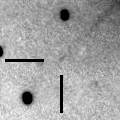
|
Now it is 17.3 mag (Aug. 22, J. L. Ortiz, N. Morales, I. de la Cueva). It keeps 17-18 mag until early 2013. It keeps observable in good condition until early 2012 in the Southern Hemisphere, although it locates low in the Northern Hemisphere. In the Northern Hemisphere, it will be observable in good condition from 2012 autumn to early 2013.
Date(TT) R.A. (2000) Decl. Delta r Elong. m1 Best Time(A, h)
Sept.17 1 8.05 -46 34.3 2.666 3.418 131 17.5 1:27 ( 0, 79)
Sept.24 1 2.82 -46 59.9 2.648 3.392 130 17.4 0:55 ( 0, 78)
|
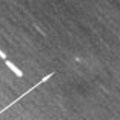
|
Now it is 17.1 mag (Sept. 8, P. Dupouy). It will be observable at 17.5 mag in good condition in autumn.
Date(TT) R.A. (2000) Decl. Delta r Elong. m1 Best Time(A, h)
Sept.17 23 24.51 -8 1.3 1.106 2.108 173 17.5 23:40 (180, 63)
Sept.24 23 20.81 -8 48.7 1.108 2.096 166 17.4 23:08 (180, 64)
|
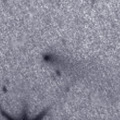
|
Although the condition is bad in this apparition, it brightened up to 12.8 mag in last winter (Dec. 24, Ken-ichi Kadota). Now it is fading. It has already faded down to 16.5 mag (Aug. 21, P. Dupouy, P. A. Mahe). It will be fainter than 18 mag in late September.
Date(TT) R.A. (2000) Decl. Delta r Elong. m1 Best Time(A, h)
Sept.17 23 58.44 -18 5.6 1.657 2.636 163 17.6 0:18 (180, 73)
Sept.24 23 51.42 -18 27.8 1.707 2.676 161 17.8 23:39 (180, 73)
|

|
Now it is 18.3 mag (Aug. 30, D. Herald). It was observed around 16 mag in 2009 and 2010. In 2011, it was observable at 17 mag from spring to autumn. But it will be fainter than 18 mag soon.
Date(TT) R.A. (2000) Decl. Delta r Elong. m1 Best Time(A, h)
Sept.17 17 4.32 -24 25.7 4.254 4.263 83 17.7 19:16 (105, 63)
Sept.24 17 8.84 -24 34.2 4.367 4.271 77 17.8 19:21 ( 99, 57)
|
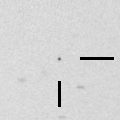
|
Peculiar asteroid moving along a cometary orbit. Now it is 17.5 mag (Aug. 1, Siding Spring Survey)�$B!#�(BIt is observable at 17-18 mag in good condition from September to November.
Date(TT) R.A. (2000) Decl. Delta r Elong. m1 Best Time(A, h)
Sept.17 3 14.61 11 20.8 1.826 2.530 124 17.9 3:33 (180, 44)
Sept.24 3 12.27 10 35.6 1.808 2.584 131 17.8 3:04 (180, 44)
|

|
Now it is 18.3 mag (Aug. 31, W. Hasubick). It will be observable in good condition at 18 mag from autumn to winter.
Date(TT) R.A. (2000) Decl. Delta r Elong. m1 Best Time(A, h)
Sept.17 3 30.53 -5 49.5 3.464 4.081 121 17.9 3:49 (180, 61)
Sept.24 3 30.74 -6 53.9 3.386 4.074 127 17.8 3:22 (180, 62)
|

|
Peculiar asteroid moving along a cometary orbit. It will pass the perihelion in winter. But it will never be brighter than 18 mag. It becomes observable in good condition in September in the Southern Hemisphere. It locates low in the Northern Hemisphere.
Date(TT) R.A. (2000) Decl. Delta r Elong. m1 Best Time(A, h)
Sept.17 0 15.38 -37 2.4 2.368 3.239 144 17.9 0:35 ( 0, 88)
Sept.24 0 11.60 -37 40.5 2.376 3.227 142 17.9 0:03 ( 0, 87)
|

|
It keeps observable at 18 mag for a long time until 2013. No observations have been reported since 2011 February.
Date(TT) R.A. (2000) Decl. Delta r Elong. m1 Best Time(A, h)
Sept.17 5 34.02 25 33.6 3.827 3.948 89 18.0 4:33 (200, 27)
Sept.24 5 37.90 25 40.2 3.721 3.945 95 17.9 4:23 (197, 27)
|
|
![]()
 C/2010 S1 ( LINEAR )
C/2010 S1 ( LINEAR ) 48P/Johnson
48P/Johnson P/2010 JC81 ( WISE )
P/2010 JC81 ( WISE ) C/2010 M1 ( Gibbs )
C/2010 M1 ( Gibbs ) 41P/Tuttle-Giacobini-Kresak
41P/Tuttle-Giacobini-Kresak C/2009 Y1 ( Catalina )
C/2009 Y1 ( Catalina ) 37P/Forbes
37P/Forbes 130P/McNaught-Hughes
130P/McNaught-Hughes 65P/Gunn
65P/Gunn C/2008 FK75 ( Lemmon-Siding Spring )
C/2008 FK75 ( Lemmon-Siding Spring ) C/2011 R1 ( McNaught )
C/2011 R1 ( McNaught ) C/2010 B1 ( Cardinal )
C/2010 B1 ( Cardinal ) 21P/Giacobini-Zinner
21P/Giacobini-Zinner 174P/(60558) 2000 EC98 ( Echeclus )
174P/(60558) 2000 EC98 ( Echeclus ) 115P/Maury
115P/Maury C/2011 O1 ( LINEAR )
C/2011 O1 ( LINEAR ) C/2008 S3 ( Boattini )
C/2008 S3 ( Boattini ) 164P/Christensen
164P/Christensen P/2011 N1 ( ASH )
P/2011 N1 ( ASH ) P/2011 R2 ( PanSTARRS )
P/2011 R2 ( PanSTARRS ) 9P/Tempel 1
9P/Tempel 1 74P/Smirnova-Chernykh
74P/Smirnova-Chernykh 2000 EJ37
2000 EJ37 242P/2010 P3 ( Spahr )
242P/2010 P3 ( Spahr ) 2010 GM163
2010 GM163 244P/2010 Q1 ( Scotti )
244P/2010 Q1 ( Scotti )![]()








































